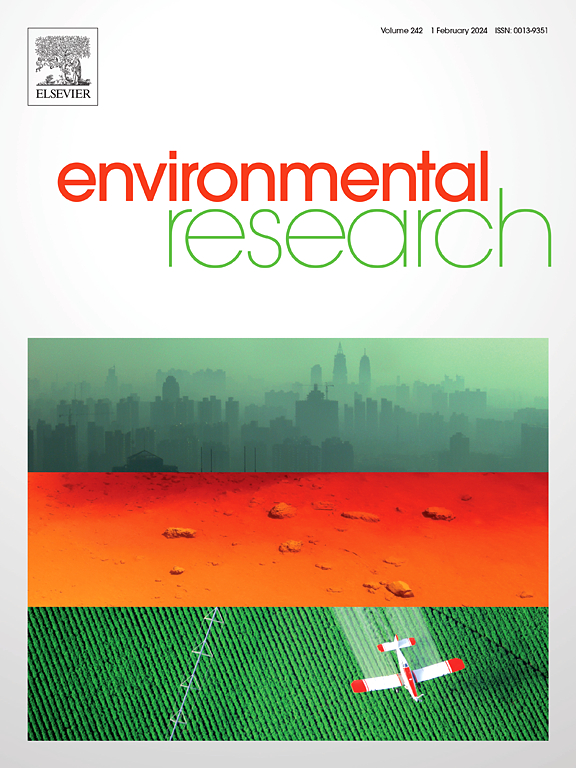Removal of 1,2-dichloroethane from groundwater using modified biochar-zerovalent copper nanocomposites in combination with potassium borohydride
IF 7.7
2区 环境科学与生态学
Q1 ENVIRONMENTAL SCIENCES
引用次数: 0
Abstract
This study investigated the removal of persistent 1,2-dichloroethane (1,2-DCA) from water using modified biochar-loaded zerovalent copper nanocomposites (nZVC/BBC) combined with potassium borohydride (KBH4) (nZVC/BBC/KBH4). Batch experiments demonstrated that 1.5 g/L nZVC/BBC with 25 mmol/L KBH4 removed 86.94 % of 100 mg/L DCA from 100 mL aqueous solution within 12 h. The removal process followed Pseudo-second-order (PSO) kinetics model, suggesting chemisorption as the dominant mechanism. The pH of the solution of 5–13 resulted in improved removal efficiency; therefore, the composite material was adaptable to a wide pH range. The co-existing ion SO42− had inhibitory effects on the removal of 1,2-DCA, whereas the effects of other co-existing ions (K+, Ca2+, and HCO3−) were minimal. The nZVC/BBC could be regenerated using NaOH, achieving over 70 % efficiency after five cycles when combined with KBH4 for 1,2-DCA removal. Characterization of the nZVC/BBC composite after the reaction was performed using XRD and XPS analyses. Adsorption kinetic models and gas chromatography-mass spectrometry (GC-MS) analysis indicated that the removal mechanism for 1,2-DCA involved both surface adsorption, pore filling and reduction reactions. In experiments using actual groundwater, the removal rate of 1,2-DCA reached 95 % when nZVC/BBC/KBH4 were 3.5 g/L and 35 mmol/L. This work has implications for the construction of materials for collaborative removal of 1,2-DCA from water by adsorption-reduction, and provides a new idea for water pollution control.

改性生物炭-零价铜纳米复合材料联合硼氢化钾去除地下水中的1,2-二氯乙烷
研究了改性生物炭负载零价铜纳米复合材料(nZVC/BBC)与硼氢化钾(KBH4) (nZVC/BBC/KBH4)对水中持久性1,2-二氯乙烷(1,2- dca)的去除效果。批处理实验表明,1.5 g/L的nZVC/BBC和25 mmol/L的KBH4在12 h内对100 mL水溶液中100 mg/L DCA的去除率为86.94%,该过程符合准二级动力学模型,表明化学吸附是主要机理。pH值为5 ~ 13时,去除率提高;因此,复合材料具有较宽的适应pH范围。共存离子SO42−对1,2- dca的去除有抑制作用,而其他共存离子(K+、Ca2+和HCO3−)的作用最小。nZVC/BBC可以使用NaOH再生,与KBH4结合去除1,2- dca,经过5个循环后,效率达到70%以上。用XRD和XPS对反应后的nZVC/BBC复合材料进行了表征。吸附动力学模型和气相色谱-质谱(GC-MS)分析表明,1,2- dca的去除机制包括表面吸附、孔隙填充和还原反应。在实际地下水中,当nZVC/BBC/KBH4分别为3.5 g/L和35 mmol/L时,1,2- dca的去除率达到95%。本研究对构建吸附-还原协同去除水中1,2- dca的材料具有指导意义,并为水污染控制提供了新的思路。
本文章由计算机程序翻译,如有差异,请以英文原文为准。
求助全文
约1分钟内获得全文
求助全文
来源期刊

Environmental Research
环境科学-公共卫生、环境卫生与职业卫生
CiteScore
12.60
自引率
8.40%
发文量
2480
审稿时长
4.7 months
期刊介绍:
The Environmental Research journal presents a broad range of interdisciplinary research, focused on addressing worldwide environmental concerns and featuring innovative findings. Our publication strives to explore relevant anthropogenic issues across various environmental sectors, showcasing practical applications in real-life settings.
 求助内容:
求助内容: 应助结果提醒方式:
应助结果提醒方式:


